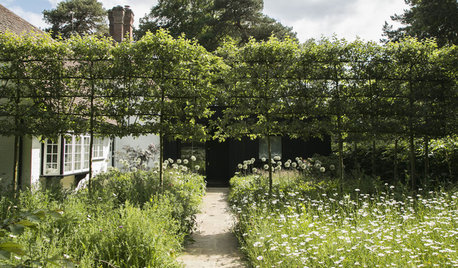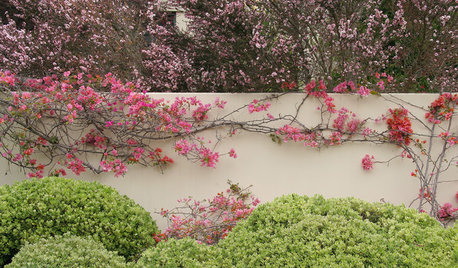Ok, so, I mentioned in a previous post that I finally convinced my local nursery to start carrying disease resistant trees. They werent requesting espaliered trees, but it was all they could get. I wasnÂt intending on purchasing one because I already had a liberty (planted from bare root last year), and IÂd never considered espaliered. But, when I stopped by the other day, they looked so good, I figured IÂd have to find a way to incorporate one. My feeling was that it would be a few years before my bare root tree would be able to produce, and this was a way to fast-forward into the future. IÂve now transplanted the bareroot tree (itÂs doing fine), and planted the espaliered tree. Along with my trellises, it acts sort of like a fence it keeps one feeling like they might fall off of my small back yard, and down the slope.
Anyway, now that I have this tree, I have a couple questions. IÂve looked online and IÂve found plenty of articles about creating an espaliered tree, but not too much about caring for an espaliered tree that is already a good size.
Question 1: This tree is already almost 6 feet tall and 1.5" in diameter at the trunk. According to the local nursery (which I have a very good relationship with), they donÂt know if it is dwarf, semi dwarf etc. But, the owner did say that this grower was did the absolutely best grafts out of all her growers. I suspect that with a grower that knows so much about grafting, theyÂd probably know what type of sizing would be best for this type of tree. With that said, can anyone speculate what size it might be?
Question 2: Can people tell me, by looking at the pictures, if these lateral branches were grafted on? Or, perhaps they (I donÂt know the right term), made a slight incision at the right spot, inserted a piece of branch (again I donÂt know the term), and encouraged a branch to grow at the right spot. Or, finally, (unlikely?) perhaps they were just the branches that were existing at nice spots where they were encouraged, and the others pruned?
Question 3: Obviously this tree will attempt to do some sort of growing Should I allow it to create another level if it seems to want to? I believe I can control the shape (strings and braces) enough to keep it in keeping with the rest of the tree. That would put the next level at about 7.5 feet. Being 6Â4", I have no problem reaching that. Would you let it grow another level?
Question 4: What about the branches when they want to grow, should I let them/encourage them to extend itÂs branches outwards? IÂm thinking in 20 years from now, as the branches get fat, they might look silly if theyÂre still only 3 feet long. If I do let them grow outwards, how should I train them? Should I do some sort of wire coiling around the existing branches to the new growth?
Question 5: Obviously the tree needs leaves on the branches. But, in keeping with the espaliered shape, I donÂt want to let the shoots (if that term is right) off the lateral branches get too large. My question is What is the best way to prune them and when? IÂm told if I just clip them off after all the leaves come off in the fall, that pruning will likely cause other shoots there next year (but maybe thatÂs not a bad thing). IÂm told that if I simply pull the shoots off by hand, theyÂre not as likely to regrow but this seams a bit barbaric to me. WhatÂs the best thing to do here?
Because this tree was shipped in a (probably warm) 18 wheeler across quite a few states, and then it was in a greenhouse for a little while to protect it from a possible frost, it bloomed a bit early compared to my other trees and the other liberty. Because of that, I suspect I probably wonÂt get any apples from it this year. As for itÂs size, its much bigger than the granny smith I planted a 2 years ago and it gave me apples the first year.
Thanks in advance for any replies!
-Glenn
{{gwi:89596}}
{{gwi:89597}}
For a larger view of the pics:
http://image63.webshots.com/663/5/39/0/2338539000015790651PZPUGI_fs.jpg
http://image63.webshots.com/663/2/18/28/2624218280015790651DWJTKT_fs.jpg
















glenn_russellOriginal Author
Posey Planter
Related Professionals
Stamford Landscape Contractors · Wilmington Landscape Contractors · Camp Verde Landscape Contractors · Del Aire Landscape Contractors · Desert Hot Springs Landscape Contractors · Fort Myers Landscape Contractors · Fountain Valley Landscape Contractors · Hayden Landscape Contractors · Hilton Head Island Landscape Contractors · Lemoore Landscape Contractors · Middle River Landscape Contractors · Milford Mill Landscape Contractors · Mount Sinai Landscape Contractors · West Allis Landscape Contractors · West Chicago Landscape Contractorsmurkwell
glenn_russellOriginal Author
glenn_russellOriginal Author
murkwell
Posey Planter
jellyman
glenn_russellOriginal Author
glenn_russellOriginal Author
Posey Planter
glenn_russellOriginal Author
murkwell
Posey Planter
glenn_russellOriginal Author